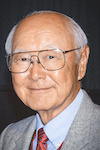
Mas Hashimoto
Set to be presented at the 2019 JACL National Convention in Salt Lake City later this month, there is a resolution before the National Council of the JACL to apologize to the “Tule Lake ‘Resisters.’” “Tule Lake ‘Resisters’” is not defined in the resolution, named R-3. Who, specifically, are they?
I am Mas Hashimoto of the Watsonville-Santa Cruz JACL. I was a POW, a prisoner of war, held by my own country. I was imprisoned without charges, attorney, trial or due process of law. My prison number is 12524 D, Poston, Ariz.
How many of you remember vividly what life was like in camp when the “No Nos” and the pro-Japan groups attacked our JACL leaders?
I was taught, when you hear good advice — take it. It could come from a sign — “Road closed, bridge out.” From a 5-year-old child. From the Scriptures and Dharma. Life is about making choices and living with them.
Ninety percent of the 120,000 camp incarcerees took the advice of the JACL and chose “Yes, Yes” on the loyalty questionnaire — 90 percent! They were to choose wisely.
Do you remember the beatings of JACL leaders in camp before the loyalty questionnaire was presented?
During the Manzanar riots, Dr. James Goto and his wife, Dr. Masako Goto, hid JACL leader Fred Tayama between two mattresses in the hospital. For their safety, the doctors were relocated to another camp — Topaz.
Dr. Masako Goto remarried. Today, she is Dr. Masako Miura and is our oldest W-SC JACLer at age 105. She’s been featured on PBS-TV and other programs.
In Poston, our National JACL President Saburo Kido was beaten twice by the pro-Japan groups, the last one in front of his wife and child. He was hospitalized for weeks. He had to be transferred out to Topaz.
In Poston, the pro-Japan group threatened our family, for my Issei mother and Kibei brother wouldn’t join them. She called them, “A ho!” Fools. My Kibei brother is a draft dodger but of the Japanese Army. In 1937, he was to be drafted. He borrowed money and got back here. Another brother fought and died for the Japanese. Two others fought in the MIS against Japan. Noriyuki, age 14, was killed in our first prison — the Salinas Assembly Center. It was a baseball accident. Another served in the Korean War in the US Navy, and I served in Sixth Army’s top-secret Chemical Section during the Cold War of the 1950s.
But in Topaz, the pro-Japan group beat Professor Chiura Obata of the University of California, Berkeley, who wished simply to teach art to the young and old. He was hit in the face with a lead pipe. They believed he was cooperating with the War Relocation Authority.
In Heart Mountain, the Mineta family was threatened, for Norm’s older sister, Etsu, was to marry Mike Masaoka. All the windows of their room were smashed as a warning. The Mineta family had to leave Heart Mountain, Wyo.
Anyone who seemingly cooperated with the War Relocation Authority was suspect and threatened by the pro-Japan groups. We lived in fear! Not from the U.S. government but from the pro-Japan groups.
Henry Izumizaki of Poston II, Block 220, my block, volunteered to join the 100/442nd. He had to sneak out at night from camp because the pro-Japan group was going to beat him up. He was killed in action, one of 184, during the Battle for the Lost Texas Battalion!
Harry Madokoro didn’t have to fight in the Army. His father and sister had died before the war. It was just Harry and his elderly Issei mother. He was the sole surviving son, like the 1998 film “Saving Private Ryan,” exempt from the draft. Harry got others to volunteer, including a young Rudy Tokiwa. He promised Rudy’s mother that he would take care of him. Rudy survived the war. Harry was killed in Italy.
We had his funeral in Poston II. He was awarded the Distinguished Service Cross. I thought he should have received the Medal of Honor for saving his company during an ambush. Mrs. Madokoro, having no other relatives here, returned to Japan and died there. She gave her one and only son to this country, and she couldn’t be a citizen of the United States! That, thanks to the JACL, was changed in 1952.
When the pro-Japan and No Nos were sent to Tule Lake, we were happy. There was peace in the camps, and we got on with winning the war.
A pro-Japan Issei mother, strong willed, was glad to go to Tule Lake, and she was delighted that a Japanese language school was established for her children. Nihon wa makenai. Japan won’t lose, she boasted. She was shocked when Japan lost. She and her family didn’t have to go to Japan. She was grateful to the JACL and became our member. She happily sang “God Bless America” in katakana.
In Japan, those families didn’t receive warm welcomes. They were asked, “Where’s your loyalty? You should have been loyal to the United States.” Chushingura — 47 Ronin. They were grateful to be able to return to the United States.
More than 800 Nisei soldiers were killed in action while serving us — you and me!
More than 30,000, men and women, faithfully served our nation in the military during WWII. Today, many Sansei and others have faithfully served and are serving — among them, Gen. Eric Shinseki and Adm. James B. Harris Jr.
Question: Who, among you, is going to apologize to our families who were threatened and beaten up?
I give you good advice. Vote “No” on this resolution.
Mas Hashimoto is a member of the Watsonville-Santa Cruz JACL.



